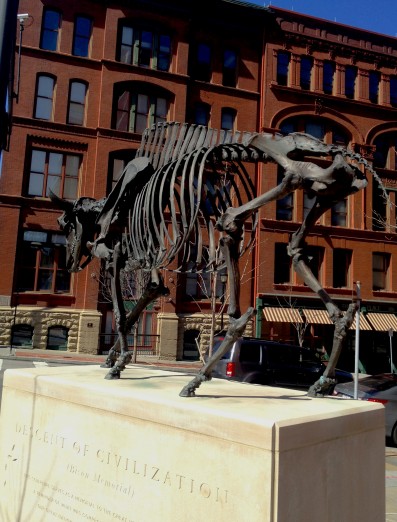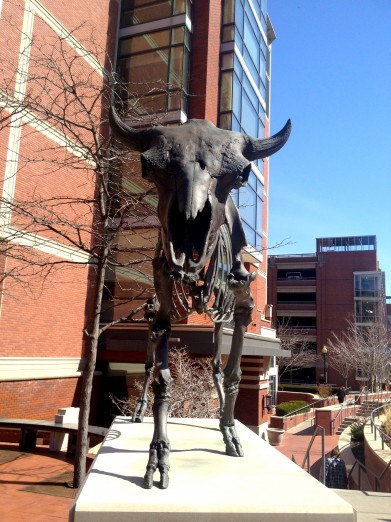The Descent of Civilization
Bison memorial, 1 of 3 in a series, permanent bronze installation, 9th & Broadway, Quality Hill
“The primary cause of the buffalo’s extermination,” writes zoologist William T. Hornaday, “and the one which embraced all others, was the descent of civilization, with all its elements of destructiveness, upon the whole of the country inhabited by that animal.” Etched into the limestone at the base of the “Descent of Civilization” statue at 9th Street and Broadway Boulevard, located in the downtown Kansas City, Mo., Quality Hill neighborhood, this quote led me to the skeletons created in the linear march of progress.
It’s quite a mind-trip to take, the imagined and real skeletons in each concrete foundation and glass skyscraper. Although the audience of Mark Swanson’s bronze statue of a buffalo skeleton had no say in the choice of man-made over nature-given, we owe it to the past to recognize the deadly consequences of progress. Maybe 9th and Broadway existed as a scrubby little piece of land with nothing but a river view to offer the world and humans have improved the land’s beauty with our magical, gleaming skyline of beanstalks. But it’s hard not to imagine wind-swept grass, a rumble of buffalo kicking off cyclones of dust, the thunder, the grandeur of nature in action.
“‘Descent of Civilization (Bison Memorial) is very strong and majestic and bronze and bold,’” Swanson told KCUR in 2010, “but also it’s a skeleton, and has a different read to it.” The dichotomy of the American Buffalo. We can see the Bison as the majestic animal that filled the plains and fed civilizations, but we can also imagine carcasses piled high upon covered wagons, its boards slick with blood, rifle bores melting from the thousands of bullets passing through its barrel, eradicating an entire species. From nuisance to art, it’s the bison’s journey.
Unveiled in 2010, Descent of Civilization is the third sculpture placed in Kansas City’s downtown loop through a partnership between the Kemper Museum of Contemporary Art and DST Systems, Inc. The first Mesteño (Mustang) (1997) by the late Luis Jimenez was placed in 2004 at the corner of 12th and Broadway on the grounds of Kansas City Southern. In 2005, the playful artwork Putto 2x2x4 (2005) by Kansas City native Michael Rees was placed just west of the historic Folly Theatre on 12th Street.
Since 1986, when the 1% for Art Program was initiated by Kansas City’s city council, 1% percent of every budget for new construction must be set aside for aesthetic ornamentation. The “aesthetic ornamentation” ranges from the iconic Sky Stations by R.M. Fischer atop Bartle Hall to the nature-affirming Barnacles by husband and wife team, Rie Egawa and Burgess Zybryk. Embedded into the Block 110 garage at 12th and Walnut, Barnacles takes a different stance from the Swanson sculpture. The artists conceptualized how, a few million years ago, this area was an ocean and how, over time, nature has a spectacular way of overtaking things made by humans. Barnacles are particularly adept at adapting to life atop human-made objects. Within the same tiny corridor of Kansas City exists public art that asks us to consider the natural cost of civilization while another asks us to bask in the adaptability of nature in response to a civilization’s descent.












